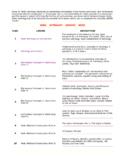Transcription of The Mystery of the Zodiac - Vedic-Astrology.net
1 The Mystery of the Zodiac by Ernst Wilhelm The path of the Sun, which is known as the ecliptic is divided into twelve divisions of thirty degrees each. The common Sanskrit word for one of these divisions is a Rasi. Rasi means a group, a quantity, a mass, etc. In the context of astrology , as well as in mathematics, it refers to the quantity of 30 degrees of an arc, which posses the colorful names of the twelve signs of the Zodiac : Aries, Taurus, Gemini, Cancer, Leo, Virgo, Libra, Scorpio, Sagittarius, Capricorn, Aquarius, and Pisces. Rasis and the Zodiac are generally considered to be a very simple aspect of astrology , with little room for Mystery . However, the world is divided in its interpretation of exactly how to calculate a Rasi. The Greeks, Persians, Egyptians and the modern world of Europe along with its offspring in the Americas consider a Rasi to be a thirty degree arc of the ecliptic as measured from the Vernal Equinox (the position of the Sun as it crosses the equator on the first day of spring).
2 This is known as the Tropical Zodiac . The East Indians, on the other hand, consider a Rasi to likewise be a thirty degree arc of the ecliptic, but as measured from some fixed point of the starry heavens. This is known as the Sidereal Zodiac . This difference in thought is a serious handicap to astrology as a science. While some astrologers have the tolerance to accept both views as there being many paths, and more ways than one to skin a cat, . the astrologer with a critical and scientific mind will appreciate the need for the definitions of astrology to be accurately defined and there being precise and scientific methods of astrological practice which are replicable and worth following as compared to sloppy methods which are no better than imaginative guesswork. Though the intuitive astrologer can have skilled and enviable guesswork, . his use of astrology does not fulfill the scientific requirements of replicability and techniques that can be passed down to students.
3 The many different traditions of astrology have too many similarities to be considered different schools of thought. The mere fact that the Rasis go by the same names within all the different Zodiacal traditions reveals that all these traditions are all offspring of one much more ancient and greater tradition. While we can not go back eight thousand years to study this great tradition, nor are documents available from that time, we can go back very far in time and study fragments of information in the Rig Veda and study precise texts from 1300 BC and onwards that may help us understand the Mystery of the Zodiac . Before studying Zodiacal information in these texts it is important to understand some background information. PREDICTIVE ACCURACY OF ASTROLOGERS. Most Vedic Astrologers claim Vedic astrology to be 90%. accurate. Yet only half of these astrologers predicted the last presidential election correctly. Is it the fault of the astrology or the Astrologer?
4 To its credit, Vedic astrology makes use of Nakshatra Dasas, which allow the astrologer to see what planet is most significantly influencing the life at any given time. Simply knowing this helps an astrologer tremendously. For instance, staying up late in a motel room with an Indian astrologer with both of us laying in our individual beds and staring at the ceiling the conversation naturally turned to astrology . He asked me what Dasa I was in, to which I replied that I had just started the Moon Dasa. Before Moon Dasa is Sun/Venus Dasa, so he replied, so in Sun/Venus you broke up with a woman? To which I had, unfortunately, to answer yes. He made this prediction without seeing my horoscope, just knowing the Dasa. So many predictions can be made simply by the fact of knowing the Nakshatra Dasa, which are calculated sidereally from the Nakshatra of the Moon. There are also, many, many other techniques in vogue in India that are dependent only upon Nakshatras which provide accurate readings with out even examining a horoscope of Rasis.
5 I have not seen Vedic Astrologers rely on the qualities of the Rasis to color their predictions. Is it because they are not concerned with the details that the Rasis offer, or is it due to their Sidereal Rasis not working well for this? In any case, while some accuracy can be claimed by Vedic astrology as it is currently practiced, it can not claim 90% accuracy in its current form. Is it a problem of Zodiacs, or of something else? These days, most Western Astrologers refrain from prediction and concentrate on character instead. Not long ago, however, Western Astrologers concentrated on predictions, just as do the Vedic Astrologers and there are records of many fantastic predictions made by Western Astrologers. I have also seen predictive centered modern Western Astrologers make wonderful predictions and I have also seen them color the predictions with the qualities of the Rasis. But I have also seen them fail miserbly just as many times.
6 When they fail, do they fail because their Zodiac is incorrect? Or do they fail because the do not use Varga charts and Nakshatras? The point is that Astrologers fail more often then they would like to admit. If we consider this in the light of the possibility that Vedic, Persian, Greek, and any astrology that uses twelve signs of the Zodiac to be the same system that is fragmented with different cultures having maintained different parts of a larger original system, then the failings of astrologers are explained. Just as an auto mechanic can not be expeted to repair any and all problems a vehicle may have with an incomplete toolbox, astrologers will miss and make mistakes so long as they are working with only the incomplete Western, Greek, Persian or Vedic Toolbox, when what they need is the complete Astrologer's Toolbox. If such a toolbox exists, which it would seem it does due to the similarities of the different cultural systems of astrology , then we can only bring it together once the correct Zodiac , whether Tropical or Sidereal, is proven.
7 So any astrologer with the desire to work towards the perfection of astrology , should have an interest in discovering the correct Zodiac . BACKGROUND INFORMATION. First of all, Rasis and Nakshatras are completely different things. Nakshatras are the stars themselves and there is no question that Nakshatras much be taken in the context of the sidereal sphere. The only question is where exactly the sphere of the Nakshatras begins, which has resulted in there being several different views regarding the correct Ayanamsa. There is no astrological truth to there being a group of stars called Aries, there being a group of stars called Taurus, etc. These names where given to the constellations in the descending dark age when man began making astronomical and astrological mistakes. The stars already had ancient true names. What falls in the modern Aries constellation is, from a point of astrological truth, the constellations of Asvini and Bharani (as per the Vedic names).
8 These names go back to the beginning of man's written philosophies and they were renamed as Aries, etc. inappropriately by the Greeks, as history tells it, by Hiparchius. There is no question that the stars, the Nakshatras, in astrology are to be taken sidereally. The ancient Greeks, Chinese, Chaldeans and Indians all have ancient names for their stars and stellar constellations. The starry constellations being labeled as Aries, etc. reveal a decline in the knowledge of astrology . India has always been a land of plenty searched for by other ancient cultures. (In ancient days it was, in fact, the only place where diamonds were found.) As a result of this, the culture of India has always been influenced by other cultures. In astrology , this is quite apparent. There are several words peculiar to astrology that are the same in both the Greek and Sanskrit. While scholars debate which culture adopted which words, that is not important for our discussion.
9 What is important is that this reveals an obvious interchange between Indian and Greek astrologers. The question arises: How did two cultures interchange astrological thought if one culture used the Sidereal Zodiac and the other the Tropical Zodiac . That would be like modern western astrologers and modern Hindu astrologers getting together and exchanging techniques, which does not happen since each looks somewhat down upon the other due to the difference in Zodiac . The only answer is that they must have used the same Zodiac at some point in time. Whether they both used the Sidereal Zodiac or both the Tropical Zodiac is the great Mystery of the Zodiac .. In India to this day there is a branch of astrology known as Tajika astrology . This astrology is from the people of Tajikstan, an ancient Persian culture. In India this branch of astrology is practiced with the Sidereal Zodiac , as is all astrology in India. What is interesting is that this type of astrology is practically identical with Greek and modern astrology .
10 The Greeks, of course, interchanged heavily with the Persians, so it is no surprise that the Persian astrology alive in India today is so similar to Greek and modern astrology . The significant difference is that the Persian astrology in India is practiced these days with the Sidereal Zodiac whereas the Greeks and Persians used the Tropical Zodiac . So it is quite obvious that the Indians, after adopting the Persian system used it with the Sidereal Zodiac and not the Tropical Zodiac as did the Greeks and Persians. Here we have evidence of the Indians using techniques that were performed with the Tropical Zodiac with the Sidereal Zodiac instead. There is a history of Hindu Astrologers practicing in both Greece and Persia. Yet both these countries used the Tropical Zodiac . So either the practicing Hindu Astrologers in these countries did not influence the Tropical Zodiac of the Greeks and Persians or else they themselves used the Tropical Zodiac .







